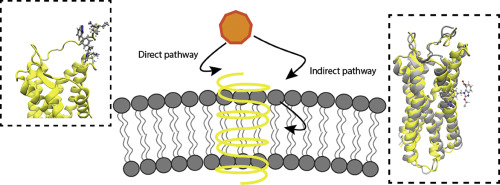当前位置:
X-MOL 学术
›
BBA Biomembr.
›
论文详情
Our official English website, www.x-mol.net, welcomes your
feedback! (Note: you will need to create a separate account there.)
Exploring the role of the membrane bilayer in the recognition of candesartan by its GPCR AT1 receptor.
Biochimica et Biophysica Acta (BBA) - Biomembranes ( IF 2.8 ) Pub Date : 2019-12-09 , DOI: 10.1016/j.bbamem.2019.183142 Sofia Kiriakidi 1 , Christos Chatzigiannis 2 , Christina Papaemmanouil 2 , Andreas G Tzakos 2 , Thomas Mavromoustakos 1
Biochimica et Biophysica Acta (BBA) - Biomembranes ( IF 2.8 ) Pub Date : 2019-12-09 , DOI: 10.1016/j.bbamem.2019.183142 Sofia Kiriakidi 1 , Christos Chatzigiannis 2 , Christina Papaemmanouil 2 , Andreas G Tzakos 2 , Thomas Mavromoustakos 1
Affiliation

|
Cardiovascular diseases and hypertension in particular are major health risks worldwide and the improvement on their treatment will be beneficial for the human health. AT1R antagonists belong to the sartans family that targets the renin-angiotensin aldosterone system (RAAS) through blocking the hormone angiotensin II to exert its detrimental effects in pathological states. As a consequence, they are beneficial to treat hypertension, diabetes related kidney failure and hyperaemic episodes. Long unbiased Molecular Dynamics (MD) simulations are performed in order to explore candesartan's possible 2D and 3D diffusion mechanisms towards AT1R receptor. 3D diffusion mechanism is referred to the direct binding of the AT1 antagonist candesartan to the AT1R 3D structure (PDB ID: 4YAY). 2D diffusion mechanism involves first, the incorporation of candesartan in the bilayer core and then its localization on the AT1R binding cavity, through a diffusion mechanism. The obtained results indicate that membranes interact significantly with the neutral form of candesartan, which is indeed approaching the receptors' active site through diffusion via the lipids. On the other hand, the deprotonated form of the drug is interacting with AT1R's extracellular loop and fails to enter the membrane, pointing out the importance of the pH microenvironment around the receptor. To validate the calculated diffusion coefficients of the drug in the lipid bilayers 2D DOSY NMR experiments were recorded and they were in good agreement. Information on the impact that has the interaction of candesartan with the membrane is very important for the rationally design and development of potent ARBs. Thus, its conformational features as well as its localization in the membrane core have to be thoroughly explored.
中文翻译:

探索膜双层在其GPCR AT1受体识别坎地沙坦中的作用。
心血管疾病和高血压尤其是全球范围内的主要健康风险,其治疗方法的改善将对人类健康有益。AT1R拮抗剂属于萨尔坦家族,其通过阻断激素血管紧张素II在病理状态下发挥有害作用,从而靶向肾素-血管紧张素醛固酮系统(RAAS)。结果,它们对于治疗高血压,糖尿病相关的肾衰竭和充血性发作是有益的。为了探索坎地沙坦对AT1R受体可能的2D和3D扩散机制,进行了长时间无偏分子动力学(MD)仿真。3D扩散机制是指AT1拮抗剂坎地沙坦与AT1R 3D结构的直接结合(PDB ID:4YAY)。2D扩散机制首先涉及 将坎地沙坦掺入双层核心中,然后通过扩散机制将其定位在AT1R结合腔中。获得的结果表明,膜与坎地沙坦的中性形式有显着相互作用,而坎地沙坦的中性形式实际上是通过脂质的扩散接近受体的活性位点的。另一方面,该药物的去质子化形式正在与AT1R的细胞外环相互作用,并且无法进入膜,从而指出了受体周围pH微环境的重要性。为了验证药物在脂质双层中的扩散系数,记录了2D DOSY NMR实验,结果吻合良好。关于坎地沙坦与膜相互作用的影响的信息对于有效设计和开发有效的ARB非常重要。因此,必须彻底探索其构象特征及其在膜芯中的定位。
更新日期:2019-12-09
中文翻译:

探索膜双层在其GPCR AT1受体识别坎地沙坦中的作用。
心血管疾病和高血压尤其是全球范围内的主要健康风险,其治疗方法的改善将对人类健康有益。AT1R拮抗剂属于萨尔坦家族,其通过阻断激素血管紧张素II在病理状态下发挥有害作用,从而靶向肾素-血管紧张素醛固酮系统(RAAS)。结果,它们对于治疗高血压,糖尿病相关的肾衰竭和充血性发作是有益的。为了探索坎地沙坦对AT1R受体可能的2D和3D扩散机制,进行了长时间无偏分子动力学(MD)仿真。3D扩散机制是指AT1拮抗剂坎地沙坦与AT1R 3D结构的直接结合(PDB ID:4YAY)。2D扩散机制首先涉及 将坎地沙坦掺入双层核心中,然后通过扩散机制将其定位在AT1R结合腔中。获得的结果表明,膜与坎地沙坦的中性形式有显着相互作用,而坎地沙坦的中性形式实际上是通过脂质的扩散接近受体的活性位点的。另一方面,该药物的去质子化形式正在与AT1R的细胞外环相互作用,并且无法进入膜,从而指出了受体周围pH微环境的重要性。为了验证药物在脂质双层中的扩散系数,记录了2D DOSY NMR实验,结果吻合良好。关于坎地沙坦与膜相互作用的影响的信息对于有效设计和开发有效的ARB非常重要。因此,必须彻底探索其构象特征及其在膜芯中的定位。











































 京公网安备 11010802027423号
京公网安备 11010802027423号